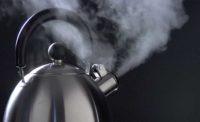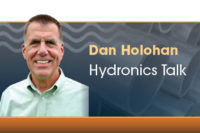Steam traps in heating systems and commercial systems may look the same but the difference comes in how we use them. Heating traps run on very low pressure and that affects how we size the trap.
It doesn’t take much steam pressure to warm people. You can see this in the definition of the term equivalent direct radiation (or EDR for short). With steam heating, 1-square-foot of EDR will give out 240 Btu/hr when there is 70° F air on the outside of the heater and 215° steam on the inside of the heater. That’s steam at about 1-psig pressure. You don’t need much, and this is how they manage to heat the entire Empire State Building with only 1 1/2 psi pressure. And that’s on the coldest day of the year.
On the other hand, commercial systems are looking for real hot surfaces. Consider an iron in your local dry cleaner. It can press clothes much faster if the temperature of the iron is, say, 338° than it can if they set it at 215°, which is what we’d see in a radiator. That higher iron temperature would be from the steam at 100 psig and this is why dry cleaners use high-pressure steam boilers and not the boilers we use to heat buildings.
The same is true for restaurants that cook with steam or hospitals that use steam for sterilizing instruments. It’s all about surface temperature. And with high-pressure systems, the traps will have smaller seats than what you find on low-pressure heating traps. You can’t use a high-pressure trap on a low-pressure system and vice versa.
Here are some things to consider when you’re working with steam traps on a heating system.
Each heater, no matter what type it is, needs its own steam trap: If you try to “gang trap” together several unit heaters, for instance, some will get hot while others will stay cold. This is because you interconnected the return lines of each heater, which causes steam to move through the heater and into the return line of the next heater. The “gang trap” will close before the air can get out of the other unit heaters because no two heaters will have the exact same pressure drop. The steam always will favor one over the other. “Gang trapping” is not a smart way to try to save money.
Never use a master trap: You can’t get by with only one steam trap for the entire heating system. If this was possible, don’t you think the guy who installed the system in the first place would have done that?
But master traps wind up on heating systems all the time. When the steam traps on the radiators or ends of the mains start to fail, they will pass steam into the returns and that steam will show up at the boiler-feed pump’s vent line. Someone will get the bright idea that one big trap, piped right at the feed-pump’s inlet, will keep the steam from venting out of the receiver.
It’s never a good idea, though. Master traps lead to water hammer, poor steam distribution, high fuel bills and very unhappy customers.
Again, if it worked, don’t you think the first guy would have done it?
Never double-trap a return line: This is another bad idea. Steam traps need pressure differential to work. The pressure on the inlet side of the trap must be higher than the pressure on the outlet side of the trap if the condensate is to move through the trap. Two-pipe steam-heating systems with condensate returns higher than the boiler’s waterline usually have
float-and-thermostatic steam traps at the ends of the steam main. If someone adds another trap further down the line, there won’t be enough pressure differential at the inlet of the second trap to move condensate through it. The condensate will get stuck between the two traps and air won’t vent from the main because of the trapped condensate. The result is lousy heat throughout in the building.
I once looked at the steam system in The Arsenal in New York City’s Central Park. The Arsenal is a landmark building and it was there before the park. They use ConEd steam to heat the building. It enters at about 125 psi and moves through two pressure-reducing valves piped in series. These PRVs drop the pressure to 7 psig. The folks in charge thought they needed that much pressure because that’s what they’d been using for as long as anyone could remember. The trouble was it took more than two hours for the building to heat in the morning and this is not a huge building.
I followed the route of the steam main and saw the F&T traps at the end of each main — exactly where they should be. Then I followed the return line after each trap and found a second F&T at the end of each of those. Those shouldn’t be there and I told the people in charge to remove them. They were skeptical at first because the second traps had been there for a long time, but they finally took my advice and now The Arsenal heats on less than 1-psig pressure — and in only 10 minutes each morning.
Double-trapping a return line always is a bad idea.
Avoid water seals: If the discharge of a steam trap drops into a water seal, you must use an air vent after the trap. The water seal often happens when the condensate-return line is at floor level and then rises up to enter a boiler-feed pump. The air vent after the steam trap will give the system air a way to get out so the heaters can get hot, and it also will break any vacuum that can form when the flash steam from the trap’s discharge condenses between the closed trap and the water seal.
Don’t line-size steam traps: If you’re using steam traps on two-pipe heating systems, the amount of condensate the trap will handle will be slight. If the trap is at the end of a steam main, it has to handle only the condensate that forms when the main goes from ambient temperature to 215°. That’s usually not much. A 3/4-in. F&T trap, for instance, can handle the condensate that forms in a 2-in. main that’s 300 ft. long. My guess is you’ll see a 2-in. trap at the end of that main, though. The reason? It looked good to the installer. Two-inch pipe. Two-inch trap. Nice, right?
No, it’s not nice. It’s dumb because the oversized trap will fail due to the wiredrawing of its seat. It barely will open to release the tiny amount of condensate and that’s what kills traps.
So don’t do it!
Beware of control valves: You’ll see them on unit heaters and steam-to-water heat exchangers. When the control valve closes, the pressure differential across the trap will be very low. All you’ll have going for you will be the weight of the condensate in the vertical pipe between the bottom of the heater or exchanger and the inlet to the trap. Size these traps for the load of the appliance at a minimum pressure differential if you want it to get rid of the condensate when the control valve closes. If the trap is the wrong size, condensate will gather inside the appliance and cause water hammer, or worse, freeze if cold outside air is moving across it.
With F&T traps, don’t depend on temperature differential: You can check thermostatic radiator traps with a thermometer. When working, they’ll show at least a 10° difference in temperature between inlet and outlet. But an F&T trap discharges condensate at steam temperature, so your thermometer won’t show a difference between supply and return temperature, even though the trap is working.
Got questions? Bring them to The Wall at HeatingHelp.com. Some of the sharpest steam people in the country post there every day.
This article was originally titled “Steam trap rules” in the January 2018 print edition of Supply House Times.





